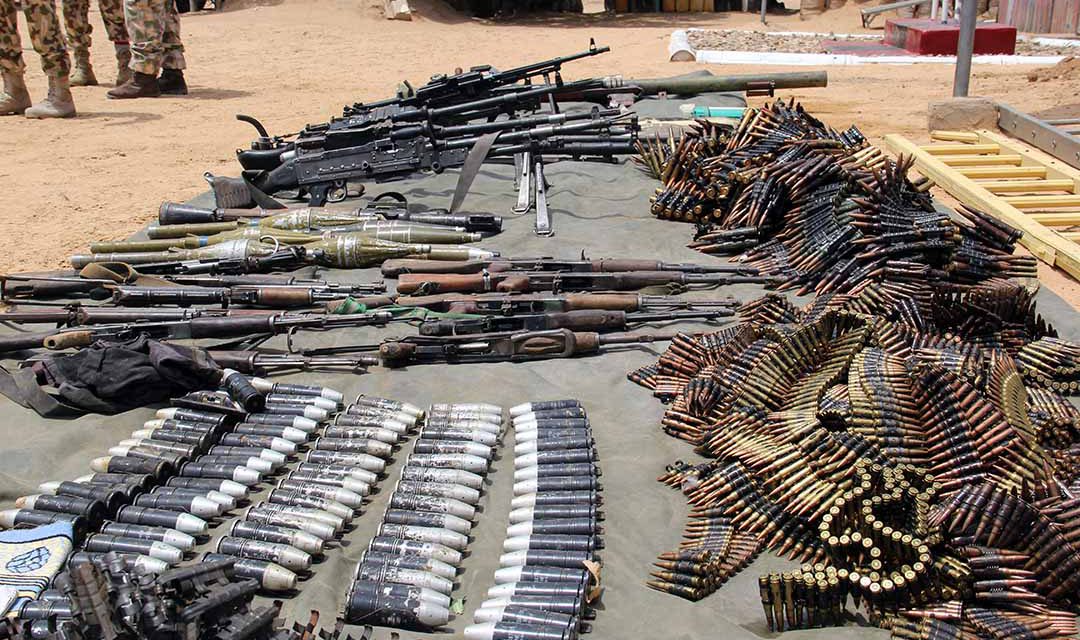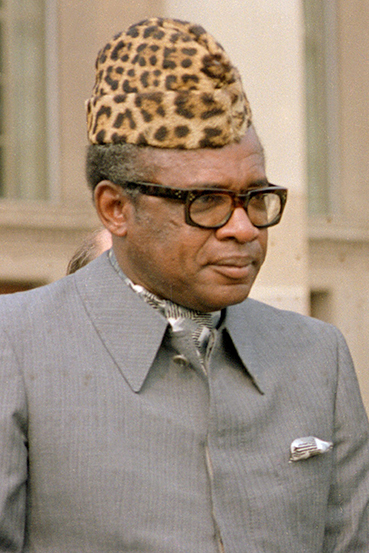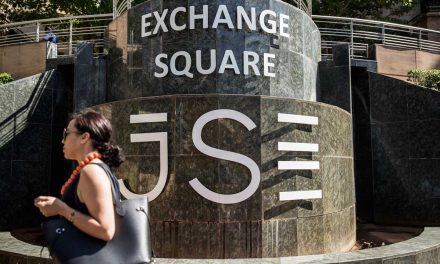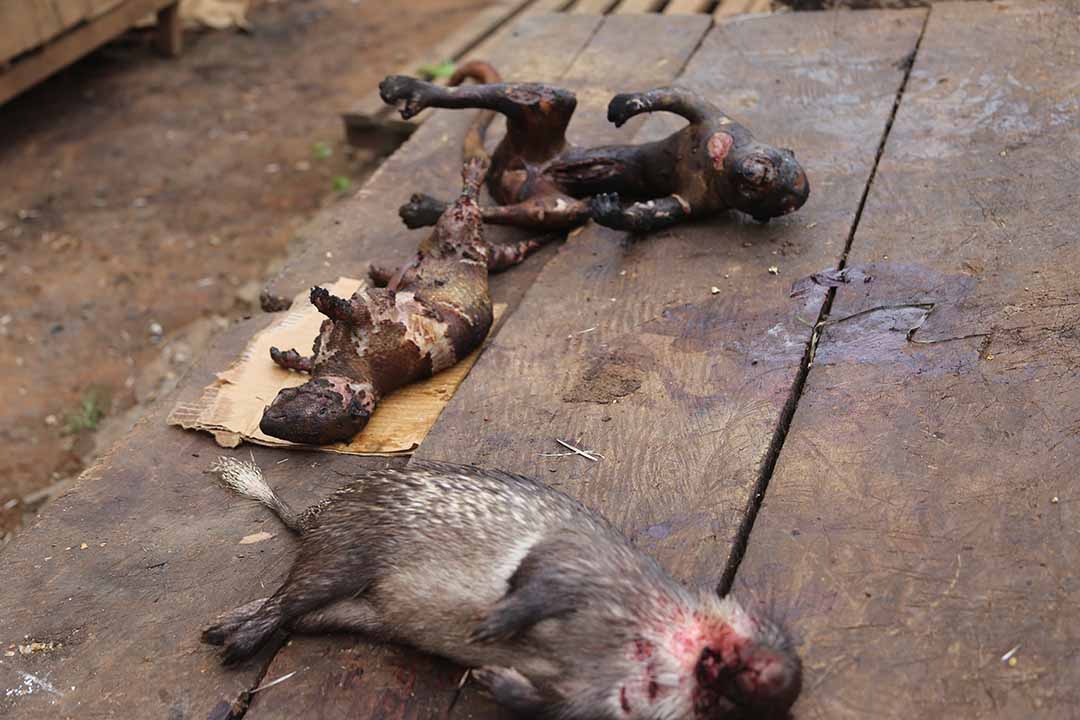Small arms and light weapons: an African overview
State fragility and political instability continue to create an ever-increasing demand for small arms and light weapons
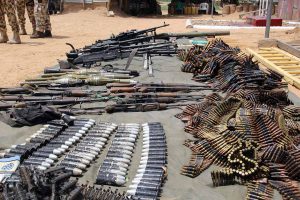
Arms and ammunition recovered from Boko Haram jihadists are displayed at the headquarters of the 120th Battalion in Goniri, Yobe State in north-eastern Nigeria in July 2019. Boko Haram’s decade-long campaign of violence has killed 27,000 people and displaced about two million in Nigeria. The insurgency has spilled over into neighbouring Niger, Chad and Cameroon, prompting formation of a regional military coalition to defeat the jihadist group. Photo: AUDU MARTE / AFP
Following the end of World War II, Africa’s period of independence induced euphoria and sense of the prosperity that would follow the decolonisation of Africa did not last long. The continent became part of the Cold War battlefield. The Cold War was essentially a clash of ideologies and economic models, with the traditional West and the Soviet-dominated East bloc competing to gain influence and expand and develop their overseas interests. Africa posed a tempting – and wealthy – prize to the winner. The continent has an abundance of natural and mineral resources, overseen by untested and weak governments, and also a range of strategic locations. During this period Africa was characterised by fragile and failed states, and virtually synonymous with wars and assassinations, coups d’état, civil wars, covert operations and destabilisation (Africa’s first self-orchestrated regime change occurred in Egypt in 1952, when the reigning monarchy there was overthrown).
As a result, the continent also became an uncontrolled dumping ground for military weapons and equipment, primarily from the now defunct East Bloc. But the problems did not end there. A rise in terror-inspired movements, transnational organised crime and acts of genocide followed the end of the Cold War. Along with collapsed economies and failing governance, government brutality and crackdowns have added to a rising sense of anger, discontent, and fear among many African populations. Any government is defined by the people involved and the institutions they adopt. The government is the direction-giving mechanism of the national trajectory, and it is responsible for the development and implementation of the policies that guide, direct, and safeguard that trajectory. Policies require action and implementation, but the continent’s governments have often failed to implement them – especially policies related to governance, security and stability.
This generates failed or fragile governments, which exploit tensions and conflict, incentivising armed criminal networks, anti-government movements and proxy forces, and allowing safety and security failures to gain traction. Given their political and social instability, many governments have strengthened their power bases and sought to improve the quantity and quality of their security forces. Often they have done so by making use of both regional and foreign government security services and equipment. Continuing instability has, additionally, led to an increase in the involvement of foreign governments and private business organisations providing governments with services that range from private security to military training and related services – often with little to no oversight. Conversely, anti-government movements have established their own militias and have armed themselves, sometimes by raiding government arsenals. Similarly, domestic and transnational criminal networks have been able to buy, steal, and sell weapons to further their criminality.
The often-glaring deficit in (multi)national intelligence and the inability of security forces to act pre-emptively have also incentivised anti-government movements and criminal groups, allowing them to act almost with impunity. Additionally, porous borders have enabled armed groups to act transnationally and find safe havens in neighbouring countries, enabling armed action against civilians and governments. Political fragility and instability, along with the erosion of national security, have led to an increased demand for weapons. For example, over the period 1990 to 2005, armed conflict cost Africa approximately $18 billion per year, according to a 2009 report by the Africa Faith and Justice Network (AFJN). The collapse of the Libyan government in 2011, for example, allowed criminals and jihadist movements to raid abandoned and uncontrolled Libyan government arsenals.
Large quantities of these weapons were moved across Africa, finding their way to groups such as Boko Haram (BH) in Nigeria (according to a captured BH member interviewed by the author in Nigeria in 2016), Harakat al-Shabaab al-Mujahideen (more commonly known as Al-Shabaab) in Somalia, and the Allied Democratic Force in the Democratic Republic of Congo (DRC). Similarly, weapons are being “lost” by law enforcement officers and military personnel on a frequent basis. In a recent case, a South African policewoman was found to have been “renting out” her service weapon to pay her debts. Available data on the proliferation of small arms and light weapons suggests that approximately 100 million weapons are available in Africa. It is, furthermore, estimated that 59% are civilian-owned, 38% in possession of government armed forces, 2,8% owned by law enforcement agencies and 0,2% in possession of armed groups, according to a February 2018 article on the AllAfrica website.
Civilians who do not choose sides or participate in violence or the small arms trade pay a heavy price for their governments’ lack of accountability and oversight of their light weapons and civilian firearms. Armed anti-government and criminal groups are able to recruit followers from a disgruntled civilian population – or coerce their cooperation. Ongoing instability and cross-border conflicts, along with armed organised transnational criminal groups, have increased the proliferation of small arms and light weapons. According to the UN Security Council’s report on small arms (S/2008/258, dated 2 June, 2009), “the dividing lines between underdevelopment, instability, fragility, crisis, conflict and war are increasingly blurred; the small arms issue is therefore intertwined with the security, development, and human rights preconditions for sustainable peace. Present-day conflict prevention, conflict resolution, and peace building require multi-dimensional interventions”, according to the AFJN report mentioned earlier.
State fragility and political instability in Africa continue to create an ever-increasing demand for small arms and light weapons by governments as well as anti-government forces and criminal networks. January – March 2020 47 Small arms and light weapons manufacturers and suppliers understand and exploit the links between political instability and the armaments market. The market space has opened up to illegal arms deals and the movement of arms by both legitimate and unscrupulous arms dealers. There is evidence that legally obtained arms find their way onto the black market, where they are sold to whoever needs them – or can afford them. Political instability and conflict have enabled private security companies (PSCs) and private military companies (PMCs) uncontrolled access in Africa. Typically, these companies have a number of roles, including offering private-sector security training and operations such as protecting high-value assets, critical industries and people. Other services include training law enforcement personnel and armed forces.
Many PSCs and PMCs abide by the laws of their hosts and work at making a positive impact, but some use the continent’s endemic instability and conflict to further their own aims. PSCs have been known to arm ill-trained personnel and to exercise little control over the weapons issued to security guards. “Misplaced” weapons usually go unreported. Meanwhile, an influx of small arms and light weapons is also due to governments evading the UN’s Programme of Action on Small Arms and its International Tracing Instrument (available on the UN Office for Disarmament Affairs site). This is particularly driven by governments aiming to expand their interests through armed conflict, either overtly or covertly. In addition to the illegal arms sales networks, there are links between the legal and the illegal trade where legally obtained arms are sold illegally. Anti-government movements, inspired by religion and supported by sectarian governments – frequently viewed as “rogue governments” – have resulted in a dramatic rise in sectarian violence, especially in North, West and East Africa.
These governments typically support regional anti-government movements in other countries, financially and morally, and by providing arms – evading UN arms controls where possible. These religious anti-government movements are gaining traction, spreading their tentacles southward as they do so. This means that the flow of weapons into previously stable regions has increased, creating ungoverned spaces controlled by armed anti-government movements. The recent deployment into Mozambique by the Russian PMC “Wagner Group” highlights the problems involved when a PMC is unprepared for its mission(s) and attacked by anti-government forces. Wagner Group members, working alongside Mozambique troops, were ambushed in northern Mozambique in late October 2019, according to a report on the Moscow Times website, and suffered numerous casualties. The antigovernment forces seized all of their weapons and equipment. Non-state actors have contributed significantly to the uncontrolled trade in small arms and light weapons.
Armed political opposition groups, secessionist movements, terrorists, criminal networks, transnational herdsmen and hunters and poachers have all added to the uncontrolled movement of this weaponry. These groups typically occupy ungoverned spaces or areas where there is little law enforcement, enabling them to use weapons to secure their own safety while exercising control over these areas and the people who live there. These groups often fund themselves by resorting to armed criminality. The proliferation of small arms and light weapons has become an impediment to the socio-economic development of many African states. Security policies, including policies aimed at controlling the flow and use of arms, cannot be implemented by fragile or failed governments. In some cases, policies are unimplementable, or make no allowance for managing and monitoring the proposed approach and legislation. Within this complex and dynamic environment, the oversight and control of small arms and light weapons are tasks that will continue to plague governments.
As noted, the lack of oversight has impacted on communities, countries and regional landscapes, resulting in a rise in armed criminality and endangering innocent civilians. It has, furthermore, prevented the delivery of economic, humanitarian and social aid, and contributed to the displacement of people and uncontrolled migration. As discussed, the uncontrolled movement and use of small arms and light weapons is indicative of poor or non-existent governance and a lack of effective security measures and policies. The proliferation of small arms and light weapons in Africa has direct, indirect, and consequential impacts on the human resources of the continent. Annually, thousands of innocent people, law enforcement officers and soldiers are killed or wounded by weapons in the hands of antigovernment groups and criminal gangs.
Governments that refuse to act decisively – and without dedicated and driven political will to improve governance, law enforcement and security – incentivise armed action against the state and against the populace. This lack of performance adds to the greed and illegality of unscrupulous arms manufacturers and traders. There is little doubt that small arms and light weapons in Africa will continue to proliferate if governments continue to neglect the politics and governance, and if they lack effective policies to reduce illegal gun control.
Eeben Barlow has served as a division commander, battalion commander, and
Special Operations Group commander for several African armed forces, where he holds the rank of major general. He has authored several books, frequently speaks
at conferences, and lectures at numerous African and foreign universities on conflict and war in Africa. He is chairman of STTEP International Ltd.

